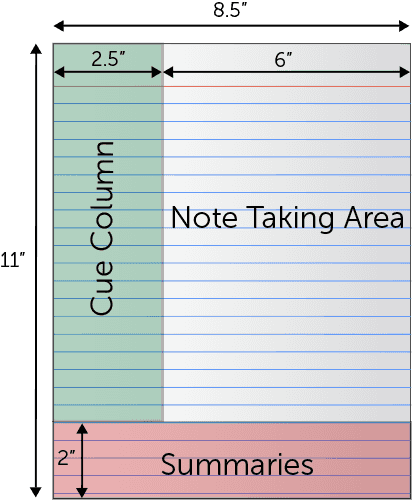The Cornell Method for Note-Taking
The Cornell Method was created by Walter Pauk, a professor at Cornell, in the 1950s. It has remained a useful strategy for students who want to create their own study-guide and useful reference system within their notes.
The system requires students to set up their notebook the same way for each day’s class. Student’s should put their name, course title, date, and lecture topic at the top of each page. As demonstrated in the diagram below, each page will include three components.

- In-Class Notes: The notes section of the page should be six inches wide and nine inches long. Students should use short, concise sentences and abbreviations. Leave several lines between each item so you can fill them in later with additional material from reading or subsequent lectures.
- Cue Column: The Cue Column should be 2.5 inches wide and 9 inches long. After class, review your notes right away and include questions or key words about the material from the lecture. Space these questions so that they line up next to their corresponding information in the “notes” section. Use this section to quiz yourself throughout the quarter; this will limit the amount of studying you will need to do at the end of the quarter.
- Summary Section: After class, when writing cues, use the summary section to write out the main points included on each page. This will allow you to quickly flip through your notebook to find relevant notes when writing papers or preparing for quizzes and tests.
Using your new notebook setup, review your notes throughout the quarter. Continue to cover the right side of the page and see if you can answer your questions in the “cue column” aloud. This self-quizzing will help you to determine how much you really know. It will also help move information from your short term to long term memory, which will help you ace your tests and papers with less studying during finals week!